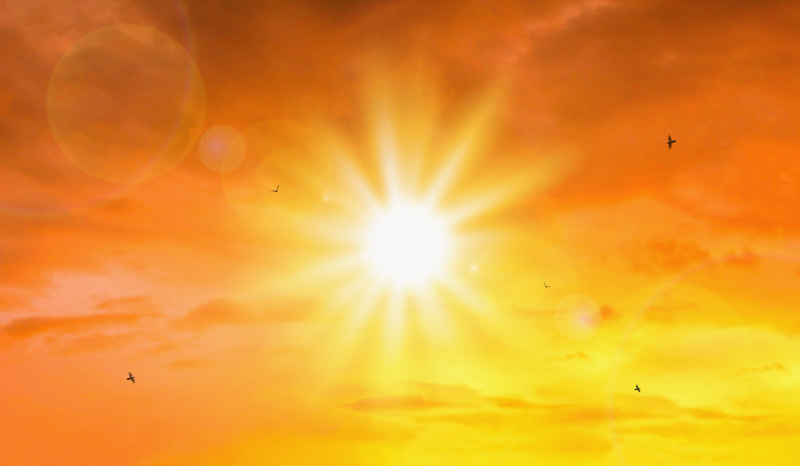Tag: Heatwave
We’re Having a Heatwave!
June 30, 2022

When you venture out of your air-conditioned comfort zone, do you immediately think, “It’s hot as Hades” outside? Extreme heat is the most dangerous type of severe-weather event in the United States. It’s easy to talk about the weather and resolve not to be able to do anything about it but you can take action to prepare for an extreme heat event. Learn what to do before, during, and after a heatwave to be safe and healthy.
Heat Emergencies
There are three types of heat emergencies: heat cramps caused by loss of salt, heat exhaustion caused by dehydration, and heat stroke. If you are experiencing any of these symptoms, get out of the heat, lie down, apply cool compresses, elevate your feet, drink fluids, and use a fan to blow cool air. Get medical help if needed.
Heat Exhaustion and Heatstroke
Heat exhaustion occurs when your body gets too hot. Untreated, this condition can lead to heatstroke when your internal temperature reaches at least 104°F. Heatstroke is much more serious than heat exhaustion. It can cause shock, organ failure, or brain damage. In extreme cases, heatstroke can kill you.
Symptoms of heat exhaustion are:
- Muscle cramps
- Heavy sweating
- Pale or cold skin
- Weakness and/or confusion
- Dizziness
- Headache
- Nausea or vomiting
- Fast heartbeat
- Dark-colored urine, which indicates dehydration
In addition to these symptoms, warning signs of heatstroke also include:
- Fever of 104°F or higher
- Flushed or red skin
- Lack of sweating
- Trouble breathing
- Fainting
- Seizures
Prevention of Heat Exhaustion and Heatstroke
There are many things you can do to prevent heat-related illnesses. Babies, children, and elderly people are more sensitive to heat and require extra attention. You are at greater risk if you are ill, obese, or have heart disease. People who work outside or in a hot setting are also at risk of heat exhaustion and heatstroke.
If possible, avoid going outside when the temperature and heat index are high. Stay indoors in air-conditioned areas. If you do need to go outside, take the following precautions.
- Wear lightweight, light-colored, loose-fitting clothing.
- Protect yourself from the sun by wearing a hat or using an umbrella.
- Use sunscreen with a sun protection factor (SPF) of 15 or higher.
- Drink plenty of water throughout the day. Dehydration and lack of salt contribute to heat-related illnesses. Some sports drinks can help replenish the salt in your body lost through sweating. Drink water or other fluids every 15 to 20 minutes, even if you don’t feel thirsty. If your urine is clear, you’re probably drinking enough fluids. Dark-colored urine is a sign that you’re dehydrated.
- Avoid alcohol and limit drinks that contain caffeine, such as tea, coffee, and soda.
- Schedule outdoor activities for cooler times of the day—before 10 a.m. and after 6 p.m.
- Take frequent breaks from the heat and outdoor activities.
- Do not stay or leave a child in your car when it is hot outside. Even if you open the windows, the intense heat can be extremely dangerous.
Certain medications can put you in danger of heatstroke. They affect the way your body reacts to heat and include some antibiotics, allergy medicines, and drugs used to manage blood pressure, cholesterol, mental health disorders, and heart disease. Talk to your doctor if you take any of these or have an ongoing health problem.
Treatment for Heat Exhaustion and Heatstroke
If you or someone near you experiences heat exhaustion, treat symptoms in the following ways.
- Get out of the heat quickly and into a cool place, or at least in a shaded area.
- Lie down and elevate your legs to get the blood flowing to your heart.
- Take off any tight or extra clothing.
- Apply cool towels to your skin or take a cool bath. This will help regulate and lower your internal body temperature.
- Drink fluids, such as water or a sports drink. Sip slowly—don’t guzzle liquids. Don’t drink fluids with caffeine or alcohol.
Call 911 if:
- Symptoms don’t improve or an affected person still has a fever of 102°F after 30 minutes of initial treatment.
- The person goes into shock, faints, or has seizures.
- The person is not breathing; begin CPR right away to try and revive them.
Living With Heat Exhaustion and Heatstroke
After you’ve had heat exhaustion or heatstroke, you’ll be sensitive to heat. This can last for about a week. It’s important to rest and let your body recover while you avoid hot weather and exercise. Ask your doctor when it’s safe to return to your normal activities.
InsureYouKnow.org
At insureyouknow.org you can keep a record of your prescriptions known to exacerbate heat-related conditions. If you do experience an emergency during a heat wave, you’ll also be able to quickly access your health insurance credentials online to help healthcare providers effectively treat you. After you recover, be sure to take recommended precautions whenever you need to endure hot weather.
